Good news! I finally made it to the Essentials of Italian Cooking course over at America’s Test Kitchen. I’ve been waiting months for this. This course includes so many goodies – I don’t even know what to do with myself. Vegetables, salads, pasta, sauces, risotto, polenta, beans, pizza and breads are just a few of the topics. I’ll probably spend a good long time in this area, if not the rest of my life, so I better pay attention.
The first recipe I tackled was Eggplant Parmesan. I prepared it yesterday and Laura and I enjoyed some of it last night. After I finished making it, I took a small taste and I have to tell you, it was awesome. I thought about dinner for the rest of the day. I couldn’t wait to dive in.
For years, I’ve struggled with preparing all types of eggplant dishes. Many of the recipes I found out there in inter-land were downright awful. I can remember attempting to make some breaded eggplant in my skillet and almost giving up because of all the oil I was using. I would walk around wondering what my malfunction was. Well, apparently, I hadn’t learned the lesson of salting the slices of eggplant to reduce the water content. This is an essential step in working with eggplant, because without taking it, you leave the vegetable’s cellular structure intact. Once you begin cooking the slices, the water evaporates and leaves all those empty cavities just sitting there waiting to be filled back up with expensive olive oil. Obviously, this is a huge problem and I just so happened to work through it yesterday. And overcoming this issue gave me one fantastic dish to enjoy.
I read a few different articles and found that they mention two ideas – one has to do with bitterness and the other has to do with liquid content. I never experienced a bitter eggplant, so I can’t speak to that. I have run into issues with excess water and soggy parmesan, so I do have some experience. Personally, salting the eggplant before using it in a recipe has solved my problem, so I plan on continuing that practice.
The Recipe
Before we begin, I want to inform you that this is a long post. I believe I include something like 38 photos. Each one covers an important step, so it may be of some value to read through and glance at each one. I can tell you that the tenderness, flavor and, how should I say it, airiness of this dish makes it all worthwhile. This isn’t a quick something to make at 6pm after work either. This is a Sunday recipe that you should begin earlier in the day. My advice is to, perhaps, double up on it and store the leftovers in the refrigerator so you have something to eat for the remainder of the week. Thank you Mrs. LaPorte for that idea. The Italians know how to do it.
Ingredients
Serves: 6-8
2 Medium Eggplants (about 2 pounds)
1 Tablespoon Kosher or Sea Salt
8 Slices White Bread
3 Ounces Parmesan Cheese
1 Cup All-Purpose Flour
4 Large Eggs
6 Tablespoons Vegetable Oil
3 14.5-Ounce Cans of Diced Tomatoes
2 Tablespoons Extra-Virgin Olive Oil
4 Garlic Cloves
1/4 Teaspoon Red Pepper Flakes
1/2 Cup Chopped Fresh Basil Leaves
10 Additional Basil Leaves for Garnish
Regular Table Salt
Ground Black Pepper
8 Ounces Good Quality Mozzarella Cheese
Step-by-Step Instructions
Here we go. Like I mentioned above, there are a lot of photos. Take your time and if you want to prepare some really great tasting and highly satisfying eggplant parmesan, bookmark this page for later.
Slice the Eggplant
The very first thing you’re going to need to do is to get both eggplants sliced up for use in the recipe, so grab your favorite chef’s knife and start cutting. Each slice should be about 1/4 thick.
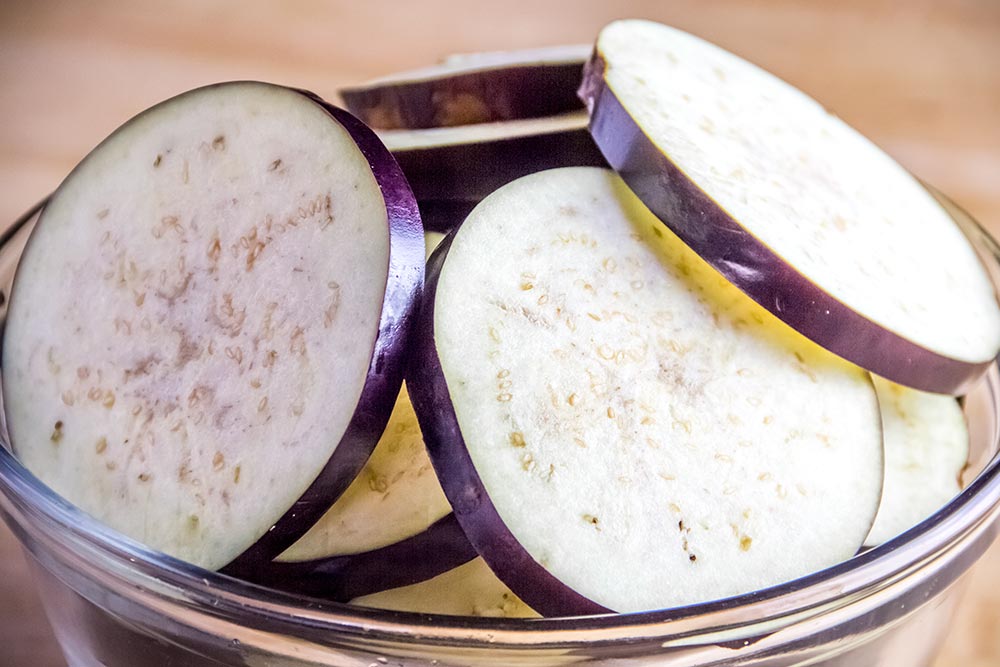
Salt the Eggplant Slices
When salting eggplant, you don’t want to use regular table salt. The grains in this type of salt are far too small for our uses and will dissolve right into the vegetable. It makes more sense to use a salt with a larger grain, so we can wipe off any excess after the eggplant has finished releasing its liquid. That’s why the recipe recommends using the larger grained sea or kosher salt.
To salt the eggplant, I took out the largest bowl we owned and added all the slices to it. Then, I sprinkled 3 teaspoons of sea salt over them. After that, I dug my hands in there and tossed all the material until it was evenly coated with the salt. Finally, I took the eggplant and transferred it to a colander that sat on top of a glass bowl to sweat for about 45 minutes. Now, just to let you know, it seems like nothing is happening for the first half hour. After that though, you’ll see some liquid dripping down into the bowl below.

Dry the Eggplant
After about 45 minutes and when you feel as though you aren’t going to get any more liquid from each slice, remove them from the colander and lay them flat on some paper towels on your counter top. When they’re situated, go ahead and place some more paper towels over all the slices and press the heel of your hand firmly onto each slice. The goal here is to squeeze any remaining moisture from the eggplant and to let the paper towels absorb it. When that’s finished, wipe off the visible grains of sea or kosher salt that’s left over.
Grate Parmesan Cheese
For this step, you’ll need to grate all the Parmesan cheese that’s called for in the ingredient list above. You’ll need approximately 1 1/2 cups of it, so that’ll take about 3 ounces. Grate it and then place it in a bowl for later use.
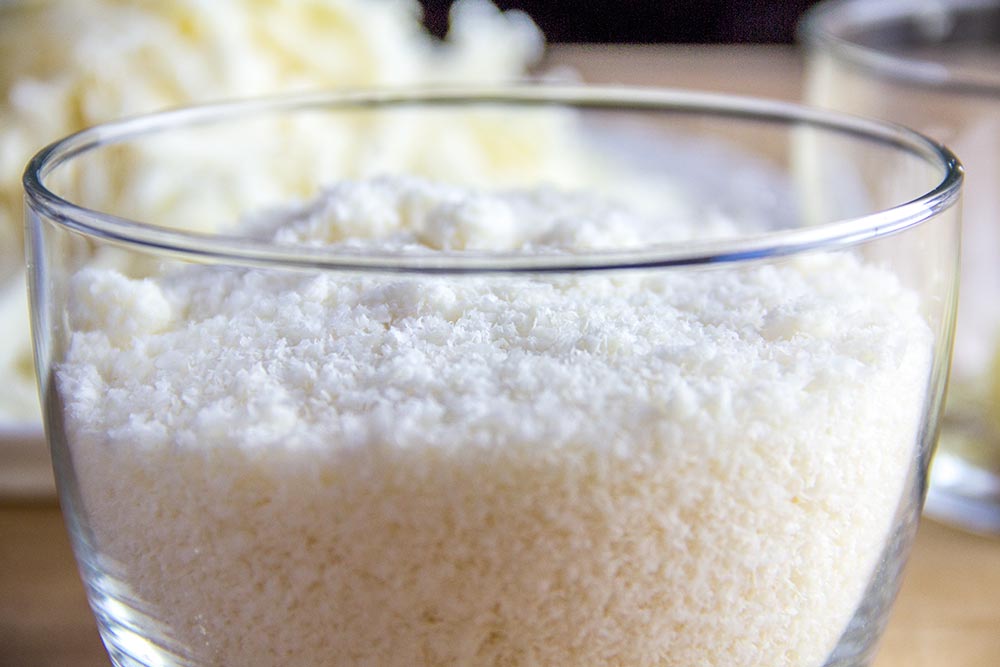
Mince or Crush Garlic
I would like to announce that I have purchased a garlic press. This piece of equipment is a miracle of modern machinery and every kitchen should contain one. Instead of peeling each clove and spending my time on mincing the 4 cloves of garlic that are necessary for this recipe, I peeled each clove and put them, one by one, in the crusher. I easily squeezed and was rewarded with an instant garlic aroma that filled the house. That, my friends, is worth the money spent. Crushed garlic is, in my opinion, way better than minced. Almost every part of the garlic’s composition is touched when it’s crushed, as opposed to just a fraction of it when it’s chopped or minced.
For this step, you’ll need to either mince or crush the 4 cloves of garlic. When you’re finished, add it to a bowl and store for later use.
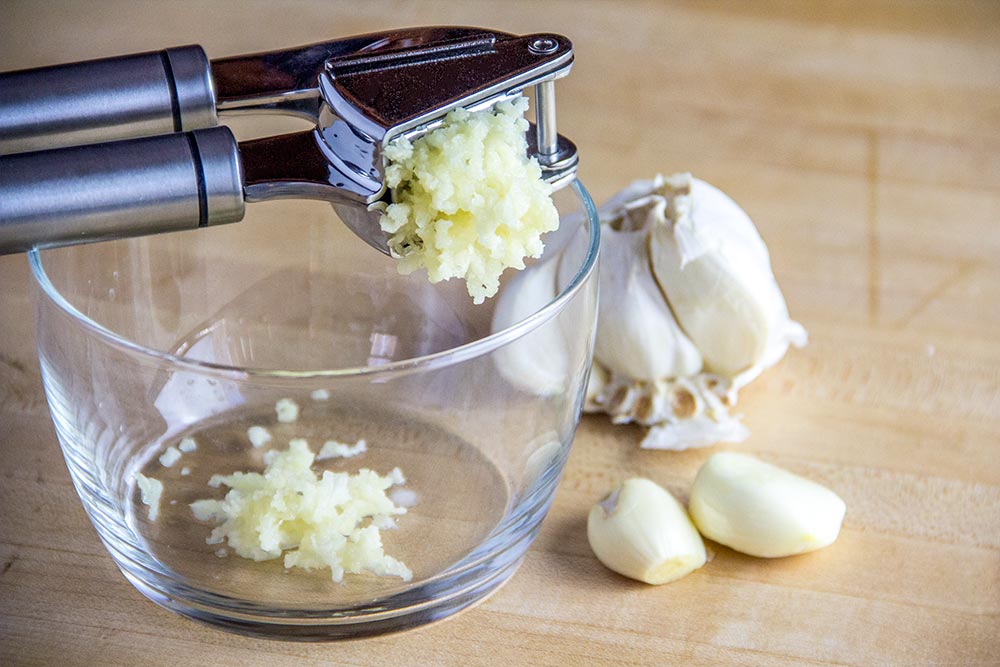
Shred the Mozzarella Cheese
After you’re finished with the garlic, go ahead and shred up the entire 8 ounces of mozzarella cheese. Store on a plate or in a bowl for later use.
Tip: I’ve read that coating the shredder with oil before you begin shredding soft cheeses like mozzarella makes the process progress much more smoothly than it would without oil. Personally, I like to chill the cheese to the point of being almost frozen before I attempt any shredding. If you don’t do something, you’ll end up with a mess. This type of cheese is way too soft to shred without any modification.

Chop Basil
I know many folks around the world like to use dried basil in their recipes because it’s relatively inexpensive and easy to store, but I’d like to tell you something. When I handed Laura a piece of this eggplant parm after it was finished, she tasted it – the first thing she said was “Mmm, that’s good basil.” For this recipe, get some fresh basil and use it.
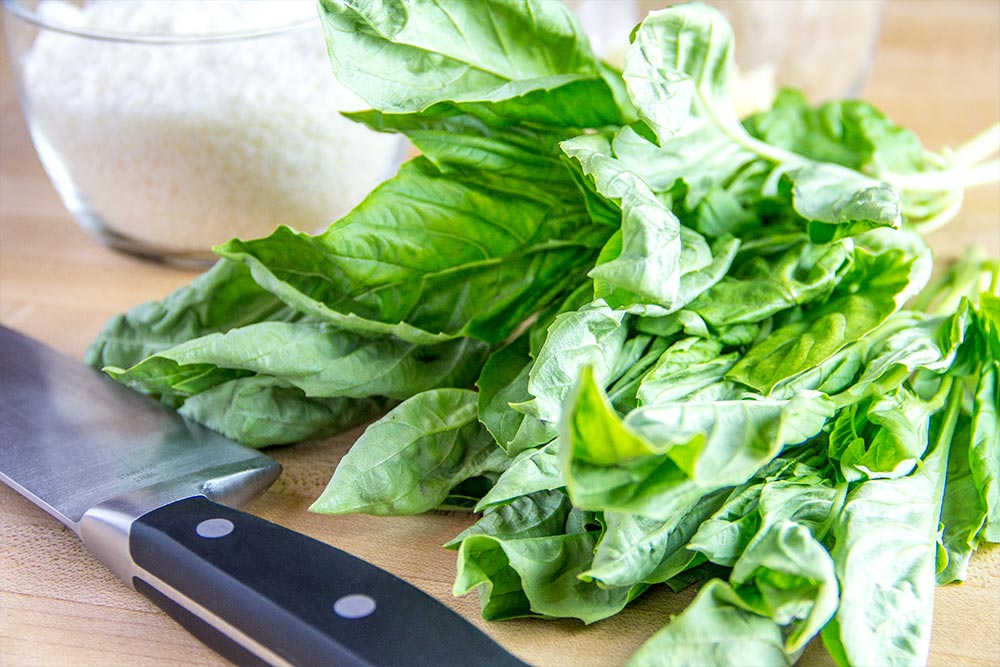
Chop the basil so it yields about a half cup. Store it in a bowl for later use.
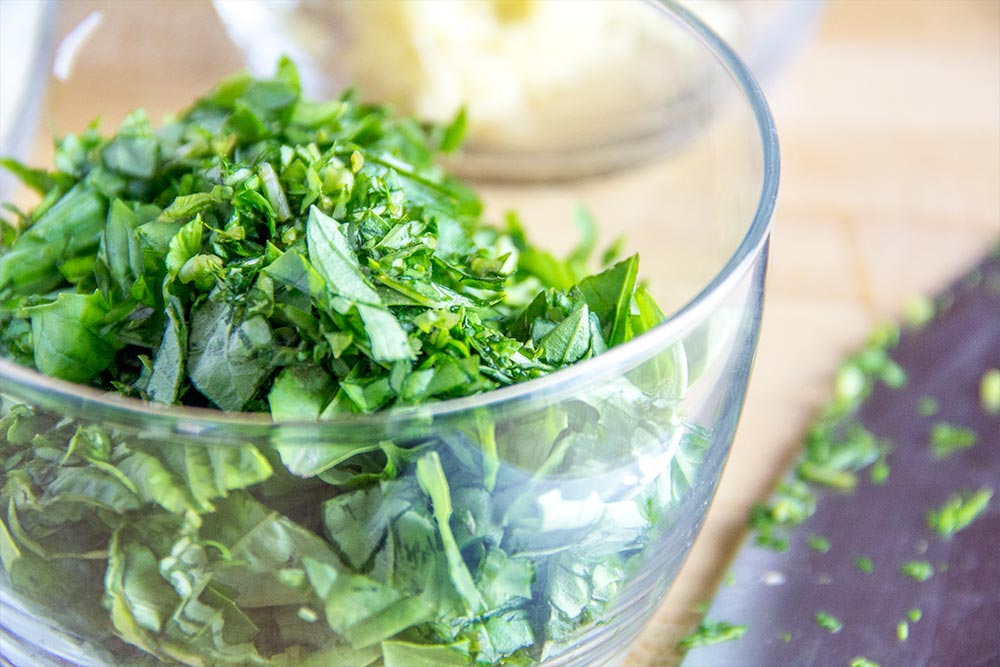
Process the Breadcrumbs
Break apart the slices of bread and add them to the food processor. You should use the large lower blade for this.
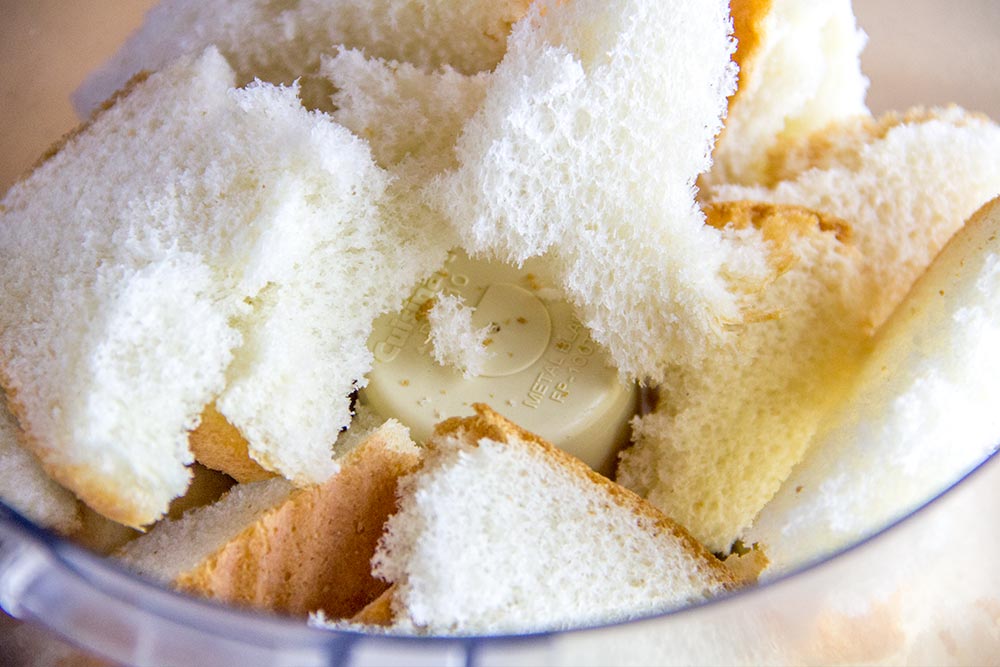
Once everything is inside, cover the processor and mix for about 5-10 seconds. If you prefer to pulse, you can do that. Just be sure you end up with evenly processed crumbs that look something like this:
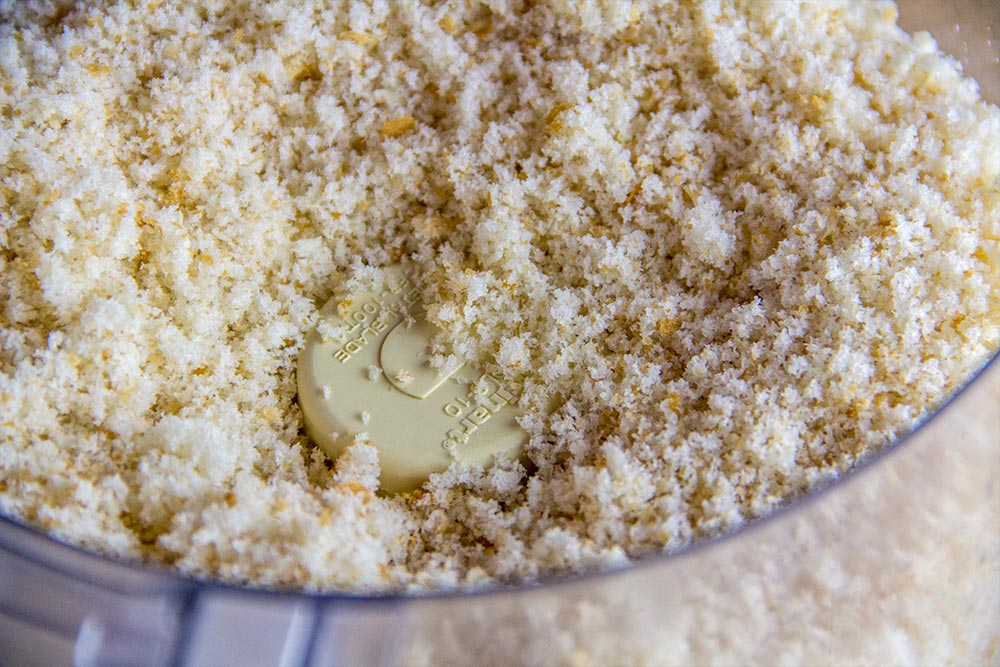
Prepare Breadcrumb Mixture
After all the crumbs have been processed, dump them into a large bowl. Add about 1 cup of the grated Parmesan cheese to it, along with 1/4 teaspoon of salt and 1/2 teaspoon of ground black pepper.
When the above ingredients are together in the bowl, go ahead and mix them together.
Arrange & Preheat Oven
At this point, you should move the racks in your oven to the upper-middle and lower-middle positions. Also, place both baking sheets inside the oven. The goal is to warm the trays up as well. Heat to 425 degrees.
Process Diced Tomatoes
For this step, add 2 14.5 ounce cans of diced tomatoes to the food processor. Use the same setup as you did for the breadcrumbs.
Mix for another 5-10 seconds until the tomato chunks are somewhat broken down. Not all the way, just not as chunky as they once were.
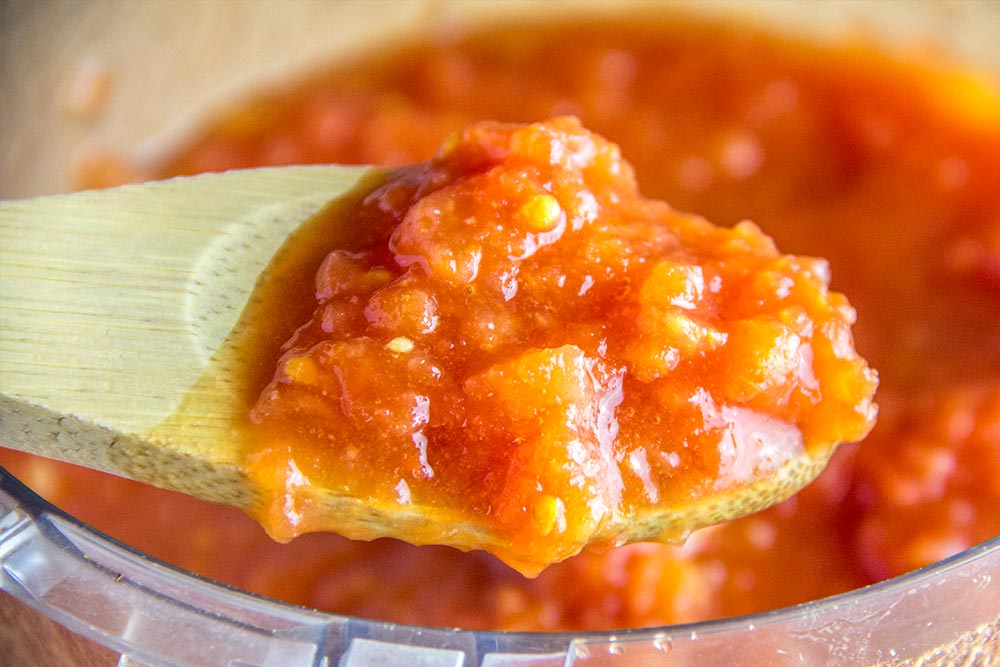
Cook Garlic & Oil
Prepare yourself for the scent of Italian cooking to fill your house. This is where this recipe starts to get real.
Add 2 tablespoons of extra-virgin olive oil to a saucepan. Toss in the minced or crushed garlic as well as 1/4 teaspoon of the red pepper flakes.
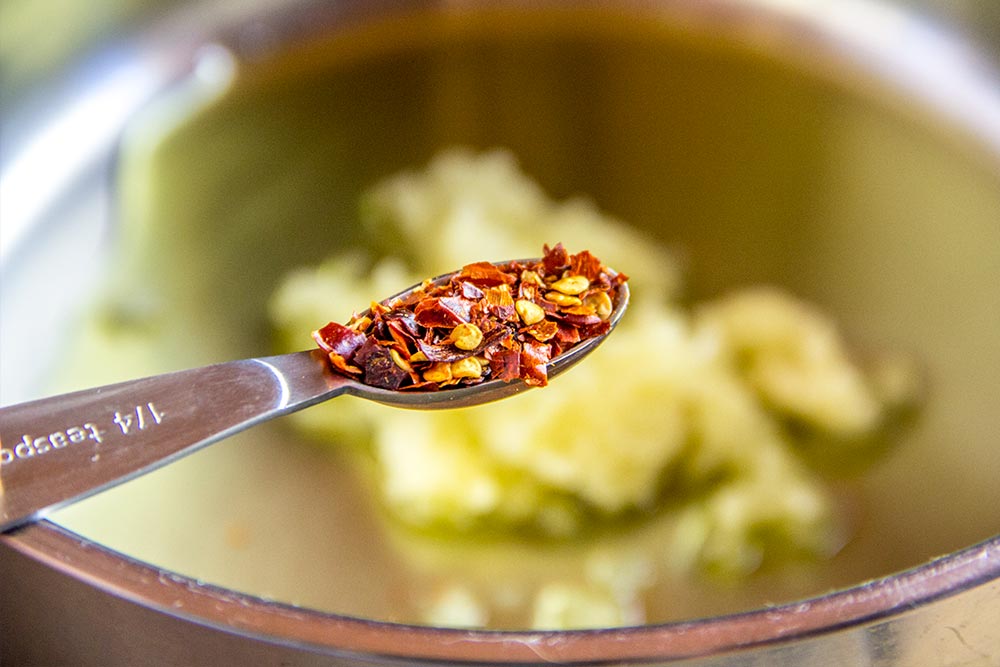
Cook all this over medium-high heat until the garlic begins to brown. This is where a lot of this dish’s flavor comes from.
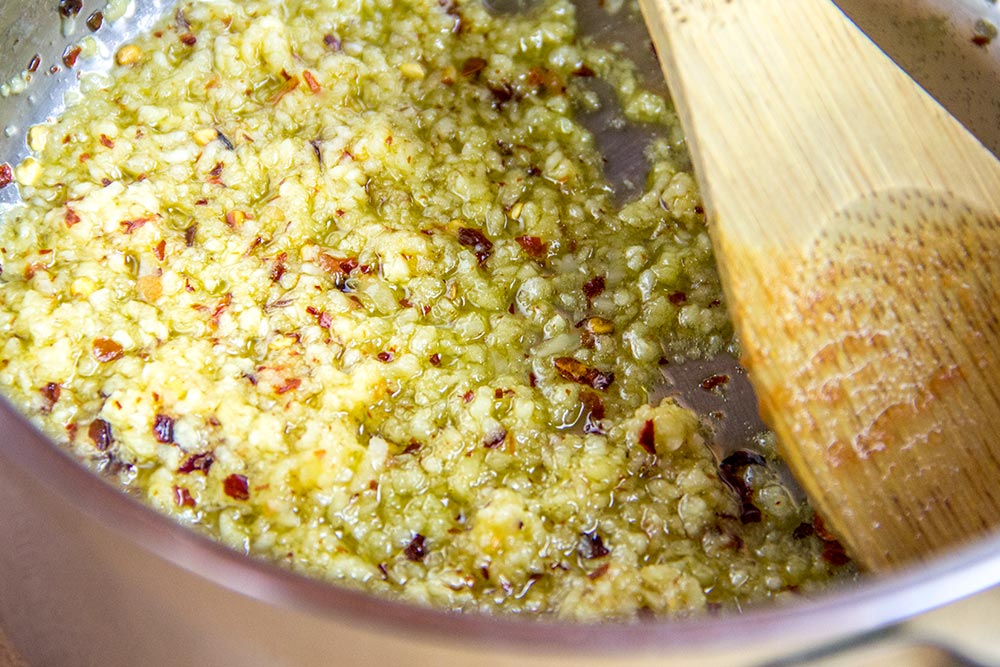
Add Tomatoes to Saucepan
Once the garlic begins to change color, add the processed tomatoes from the food processor as well as the final 14.5 ounce can of diced tomatoes. Bring everything to a boil and then reduce the heat to medium-low and let simmer for 15 minutes, uncovered.
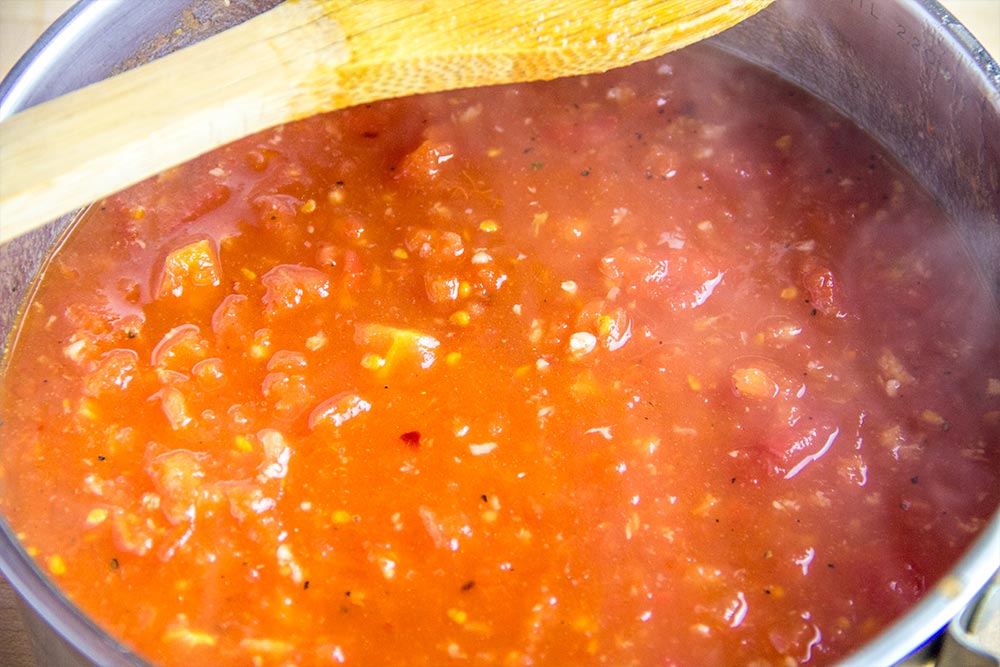
The goal with this step is to remove some of the liquid content from the diced tomatoes, so it’s important that it simmers and steams.
Add Basil & Season
After 15 minutes has passed, go ahead and add the 1/2 cup of chopped basil to the sauce. Also, sprinkle in some salt and pepper until you’re happy with the flavor.
Make Flour Mixture
Add 1 cup of regular all-purpose flour to a large bowl. Also, add 1 teaspoon pepper to that. Shake the bowl around so everything is mixed up.
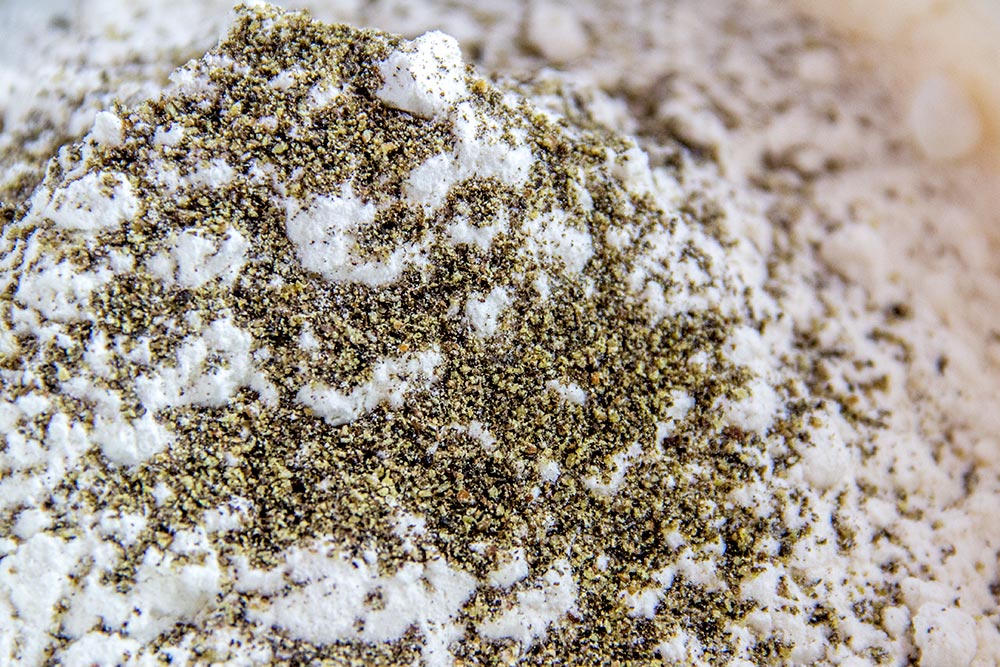
Prepare Egg Mixture
Beat 4 large eggs in a bowl until they are evenly yellow in color.
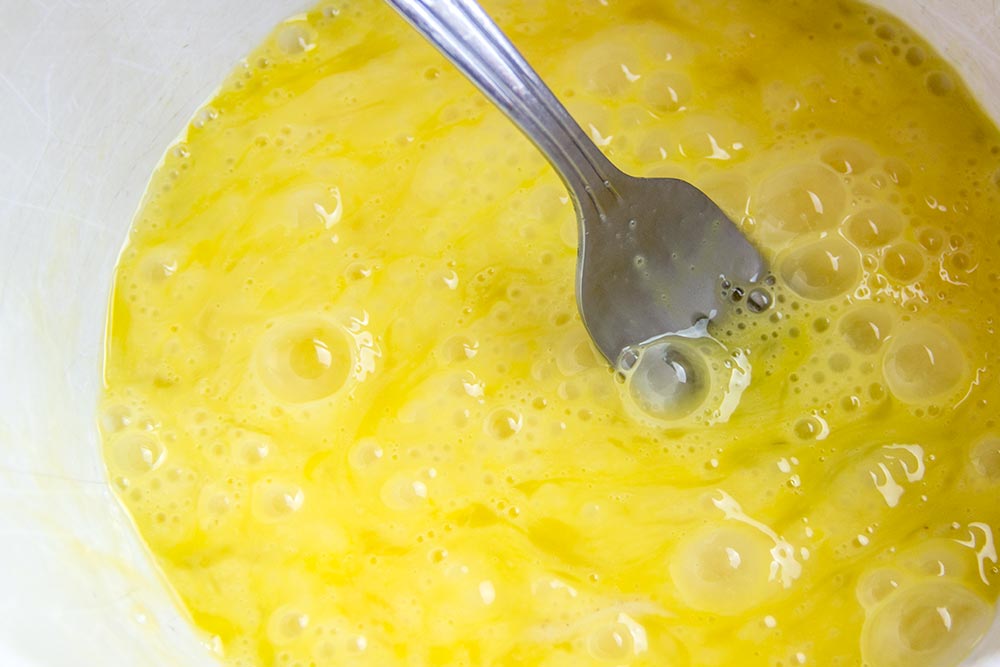
Prepare Breaded Eggplant
Once you have the flour mixture and egg mixture ready, arrange the bowls of ingredients so they’re easy to get to and work with. You can do the following steps one at a time or all together. I did them all together.
When you’re set, coat the slices of eggplant and store them on a plate.
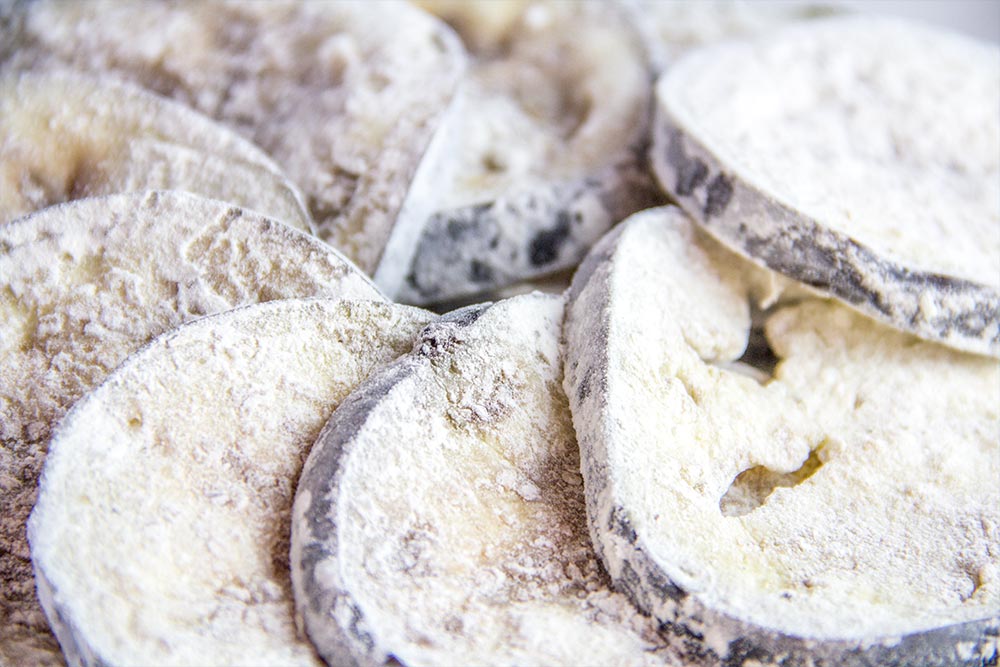
Then, coat each slice (one at a time) with egg.
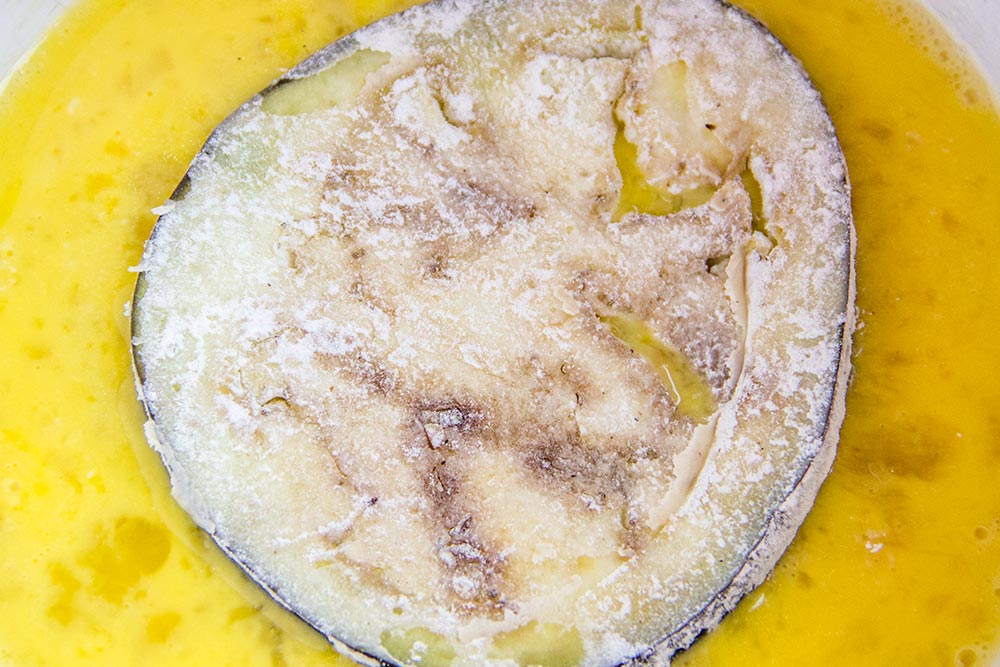
Bring each egg coated slice straight into the bowl that holds the breadcrumb mixture and cover evenly.
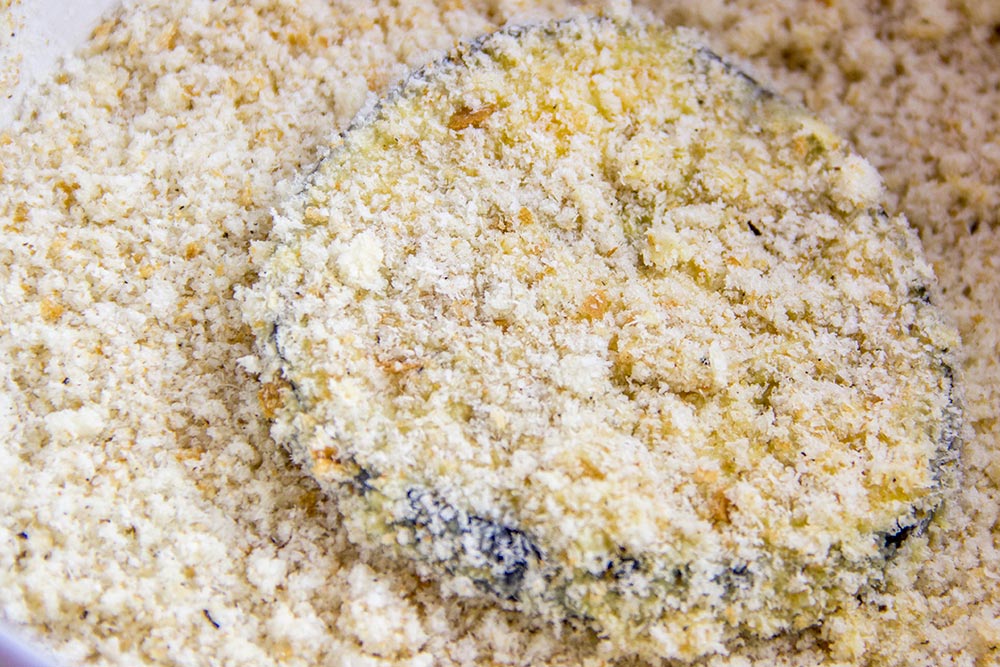
After that, store each breaded slice on a plate.
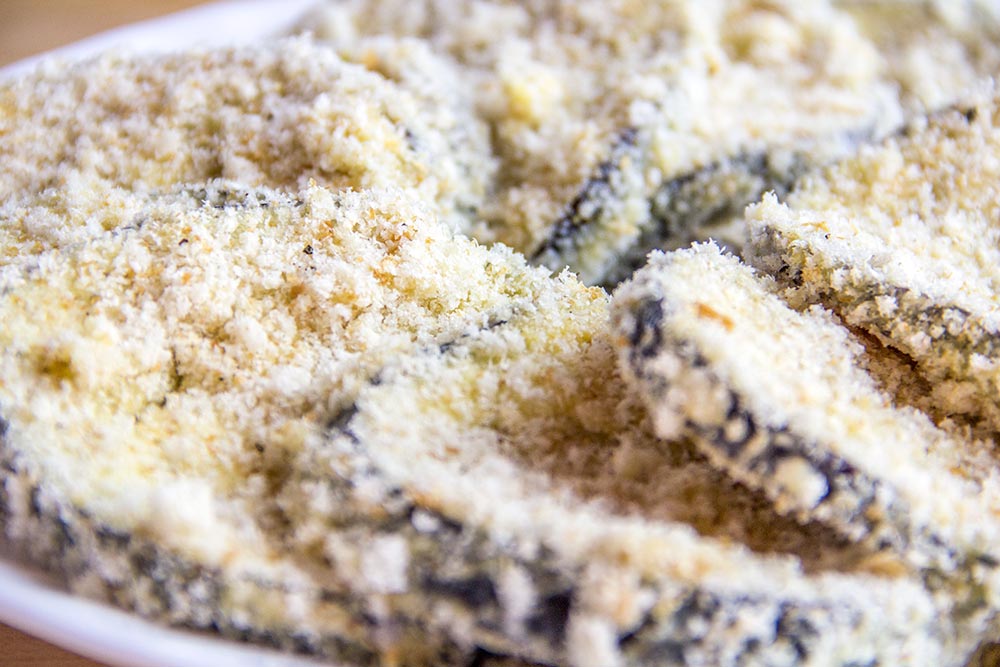
Arrange Eggplant on Baking Sheets
After all the breading is finished, you’ll need to arrange each slice on the heated baking sheets. To do this, remove one sheet from the oven, add 3 tablespoons of regular olive oil (vegetable oil) to it so it coats the entire bottom of the tray and then arrange half the eggplant on it.
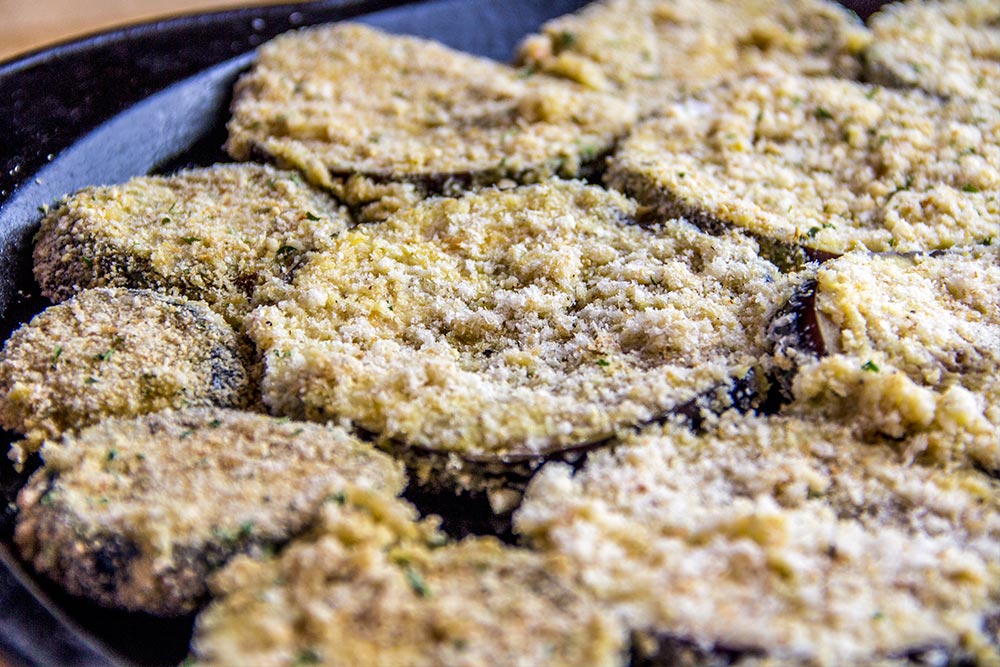
After one tray is finished, place it in the oven and repeat the process with the other one.
Bake the Eggplant
Bake both tray for 10 minutes. After that time, remove the trays, rotate them from front to back and switch racks. Basically, you want to evenly cook the eggplant as best as possible. Cook for another 10 minutes. Then (total 20 minutes so far), remove the trays from the oven, flip each slice of eggplant and place back in the oven for another 10 minutes. Total cooking time should be 30 minutes. The slices should look like this:

Tip: Keep your eye on the oven for the last 10 minutes. This is a critical time and you don’t want to overcook and burn the breading. It should be crispy, but not overly brown. Be sure to keep the oven on at the same temperature.
Add Tomato Sauce to Casserole
Add 1 cup of cooked tomato sauce to a 13×9 inch casserole. Spread it out so it covers the bottom.
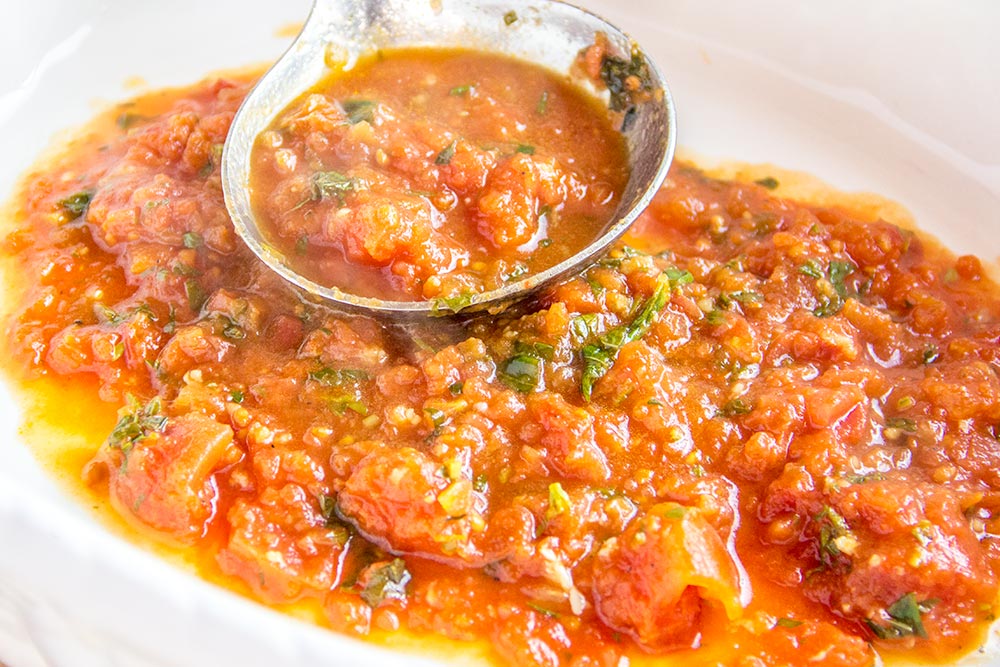
Arrange Baked Eggplant
At this point, you can arrange half of the baked eggplant slices on top of the tomato sauce you just spread on the bottom of the casserole. This is your lower layer of eggplant.

Add More Sauce
Spread out another cup of sauce so it covers the eggplant you just placed in the casserole.
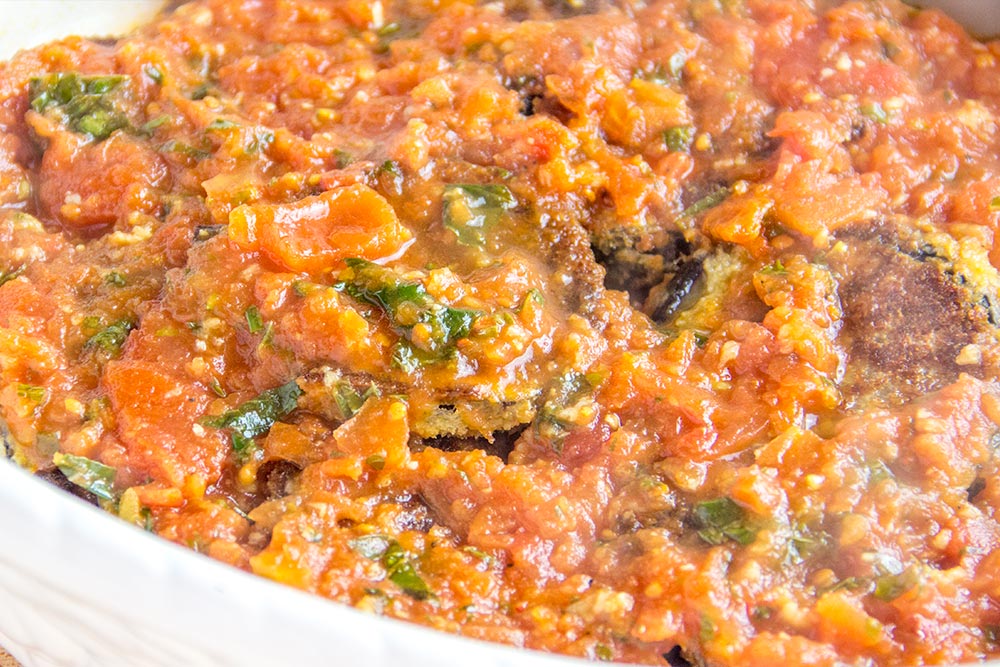
Add Mozzarella
For this step, you’ll need to sprinkle half of the shredded mozzarella cheese evenly over the tomato sauce you just added.
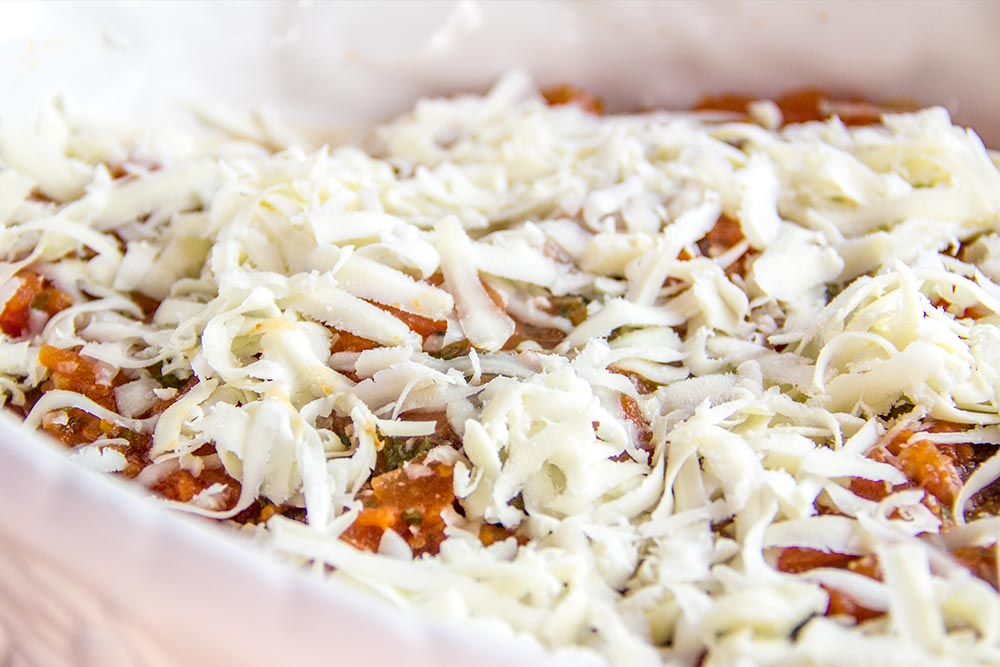
Repeat Process
After the first few layers of ingredients are added to the casserole, you’ll need to repeat the process. First, add the remaining eggplant and dab some tomato sauce to each slice. You don’t want to completely cover all the slices because they’re meant to stay crispy. Also, don’t use up all the sauce. Leave about 1 cup in the saucepan.
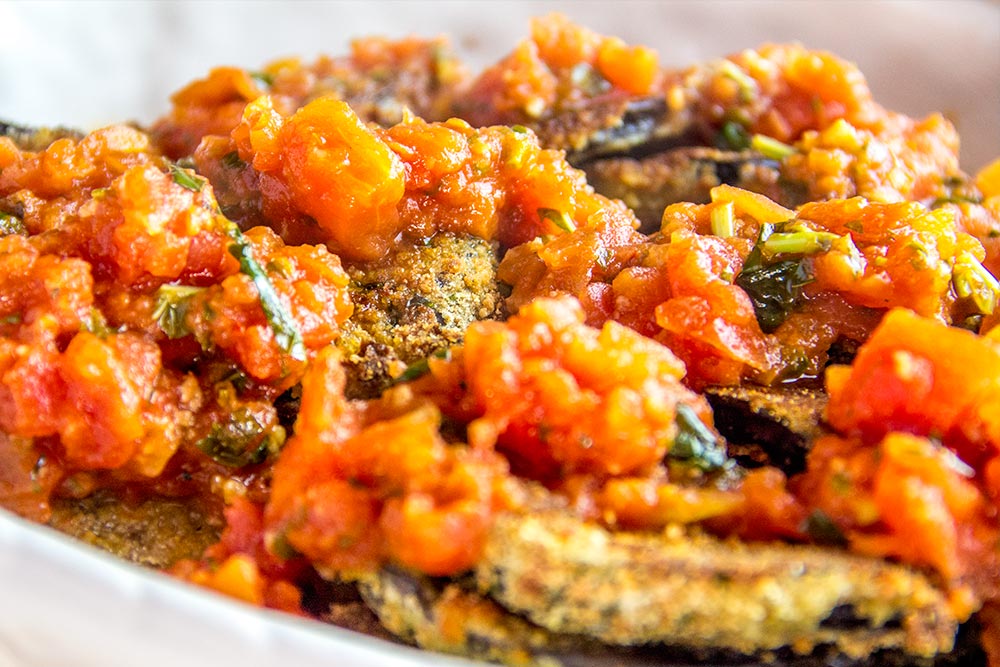
Sprinkle 1/2 cup of Parmesan cheese over the entire casserole. Then, sprinkle the rest of the mozzarella cheese on top of that.

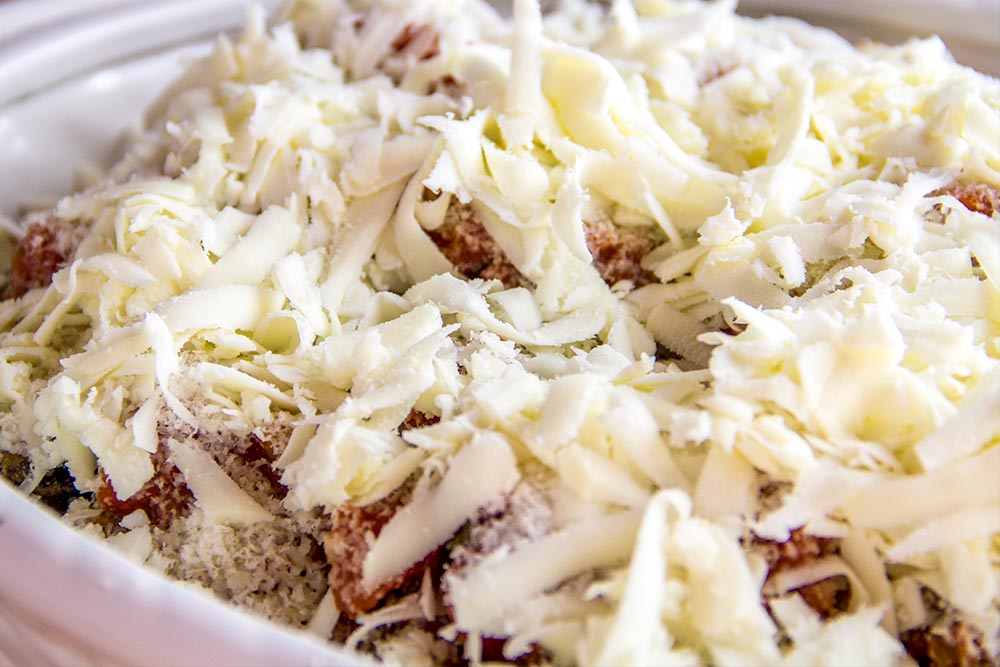
Bake & Brown
At this point, you want to add the casserole to the oven and bake it for about 13-15 minutes, until you see the mozzarella begin to brown. When it starts turning brown, remove from the oven.

Tip: It’s very easy to let the cheese brown too much. Personally, I like to keep it melted, but not cooked, so I removed the casserole from the oven at first site of browning. This keeps the cheese softer.
Cool & Add Basil
After you remove the casserole from the oven, let it cool for a few minutes. In the meantime, chop or tear some of the extra basil leaves and sprinkle them on top of the eggplant. This will add some interest as well as extra flavor to the dish.
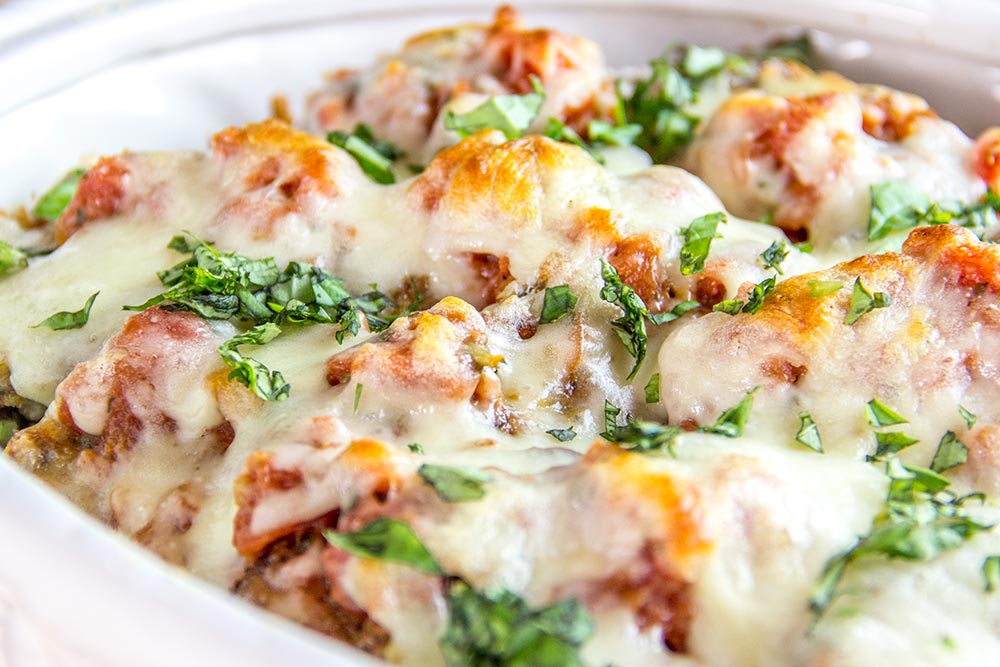
The Final Product
After everything is finished, go ahead and plate a piece and enjoy. You can pass some of the remaining tomato sauce separately. I know this was a lot of work, but I think you’ll find that it was time well spent. This is truly a great recipe.


Now that looks great. I make the eggplant, but always remove the skin. Seems to be hard to cut. I love that you make the sauce, home made. It’s an art. Looking forward to the next meal you make. Talk soon.
Thank you for the wonderful comment! You know, I never thought about removing the skins. That seems like it makes a lot of sense and would work out well. Thank you for the tip. Also, home made sauce rocks! All that garlic doesn’t help my social life, but it sure does taste good. Talk soon!